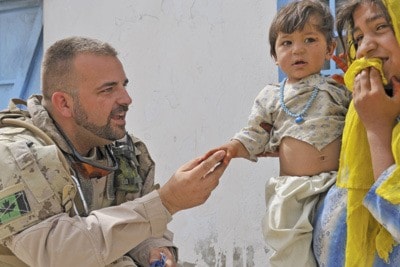Terry Hackett was in the warden’s office speaking with a man near the front gate of Sarposa Prison in Afghanistan’s Kandahar city, when the suicide bomber struck.
A massive explosion rocked the office, blowing the windows inward, and sending shards of glass slicing into Hackett.
Then came the sounds of small arms fire, as Taliban insurgents fired AK-47 assault rifles and rocket-propelled grenades (RPGs).
But this time, the prison security held.
For the Abbotsford man who spent a year as director of the corrections contingent with the reconstruction team in Kandahar, it was a sign of the success of the Canadian mission. Another assurance that they were making a difference.
Sarposa houses almost 1,200 prisoners, generally including hundreds of Taliban fighters. In a massive attack in May 2008, insurgents breached the front gate using a suicide driver in a tanker truck laden with explosives. The detonation killed security personnel in the area. A second suicide bomber on foot breached the rear gate. Then a team of 30 insurgents on motorcycles, with AK-47s and RPGs, fought to free more than 1,000 prisoners. An estimated 390 were suspected Taliban fighters.
After that attack, prison security at Sarposa had to be reinforced.
When the second attempt was made, witnessed by Hackett, there was a double gate. And the walls were designed by the military to deflect an explosion upward.
“The infrastructure we did, and the training we did, was effective that night,” said Hackett. “Our Afghan partners did their job.”
The first attack had killed 16 guards. In the second, there were 12 shrapnel injuries from the explosion.
Glass cuts notwithstanding, Hackett didn’t number himself among the injured.
“I had worse rugby injuries.”
Hackett was raised in Saskatchewan, and came to the Fraser Valley at 19 for an education in psychology at TWU. While at a university career fair, he discovered opportunities with the Correctional Service of Canada, and started as a corrections officer.
In 2008, then a warden of the former Elbow Lake Correctional Facility in Harrison Mills, he looked at opportunities to work in Afghanistan. There are four non-military organizations from Canada there – the RCMP and municipal police, the Department of Foreign Affairs, the Canadian International Development Agency (CIDA), and the Correctional Service of Canada. Before he could be placed in Afghanistan, Hackett took “hazardous environment” training for five days in Kingston, Ont., playing out scenarios such as being in a vehicle convoy that gets ambushed.
He was sent to Germany for a NATO school on counterinsurgency doctrine. In Gatineau, Que. he took cultural sensitivity training. And for two weeks in Kandahar, he shadowed the corrections team he would be replacing.
Afghanistan was a culture shock.
“It was like stepping back in time.”
The streets featured modern vehicles alongside donkey carts. He wasn’t sure of the age of Sarposa Prison, but traditional construction methods made it look older than it was.
Renovating the prison, cleaning it, building guard towers, upgrading the septic system, and ensuring it met international standards of construction, has been some of the Corrections goals. Over three years, they made $5.5 million worth of infrastructure improvements.
Rather than train frontline workers, Hackett’s team was teaching the Afghans how to instruct their own staff.
“If we go tomorrow or we go next year, we have to make sure that what we do has value, and lives on.”
There are now only 60 Canadian civilians based in Kandahar. The combat mission still includes 3,000 soldiers in Afghanistan, but they are expected to come home late this spring.
The Afghan corrections officers, like police and other government authorities, are targets of the Taliban. While Hackett was there, two corrections officials were assassinated, and there were other attempts.
In return, the Canadians respected the Afghans’ bravery and commitment to their country.
“The neat thing is to see them take pride in what they do,” he said.
When Hackett arrived, it was difficult to recruit and keep corrections officers, because they were risking their lives for only $120 per month.
The corrections contingent ran a program to hike the pay significantly, up to $160 per month, to match the pay of police officers.
Within four months, they increased staff 300 per cent and had a waiting list.
The increase cost only $45,000 for eight months. Soon $160 per month became the wage for corrections officers across the country.
Some of Hackett’s strongest memories of Afghanistan are of community engagement with people living near the prison.
Doing foot patrols with members of the Canadian military, they met with community elders.
“They are the most hospitable people when you get to know them. And there is a genuine thirst for peace from the average citizen.”
He recalls meeting a shopkeeper, who had a little closet that sold anything he could sell.
The Afghan entrepreneur said business is like a hand. Some days are long – he indicated his pointer finger; some days are short – he pointed to his pinkie; some days are bad – he indicated his middle finger; and some days are good – and he gave the thumbs up.
“People are people,” said Hackett. “All people want the same things – safety and prosperity.”
Hackett is back in Abbotsford, his home of 14 years. On his return to Canada, he was promoted to director of corrections operations for the Pacific Region.
The year in Afghanistan has changed him.
“I’m more thankful for my family, my job, and for Canada.”
His thoughts frequently return to Afghanistan.
“It was a privilege to have gone there and made a difference.”
